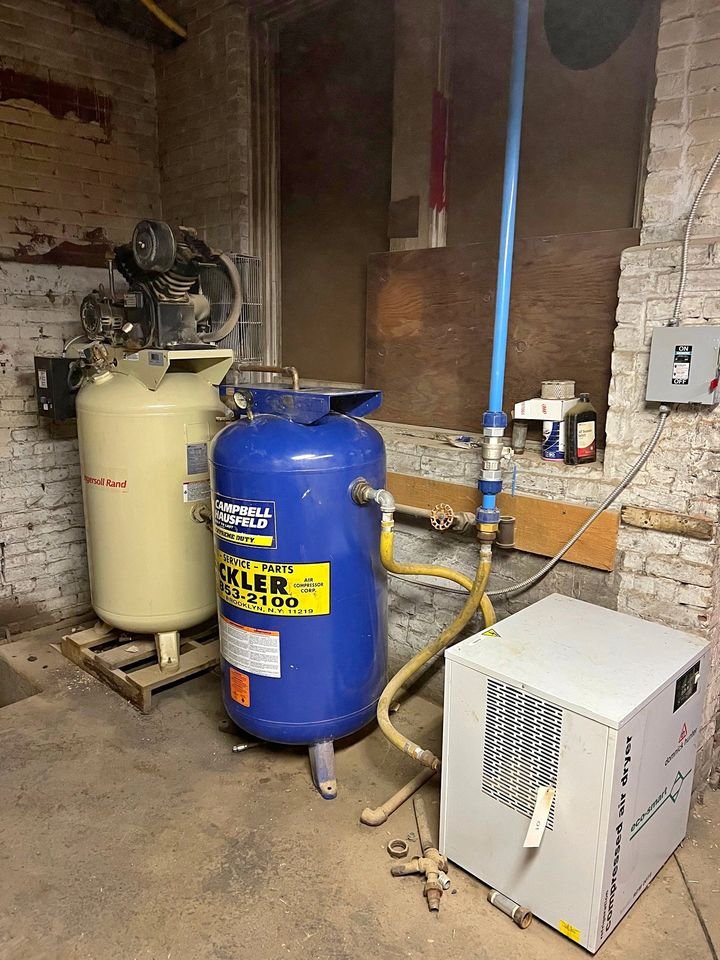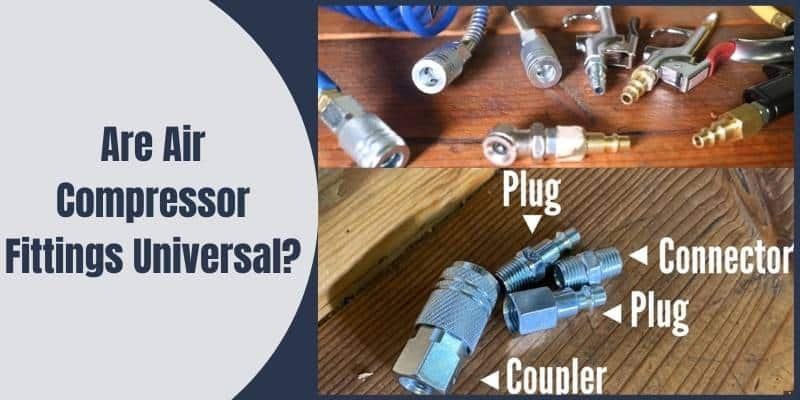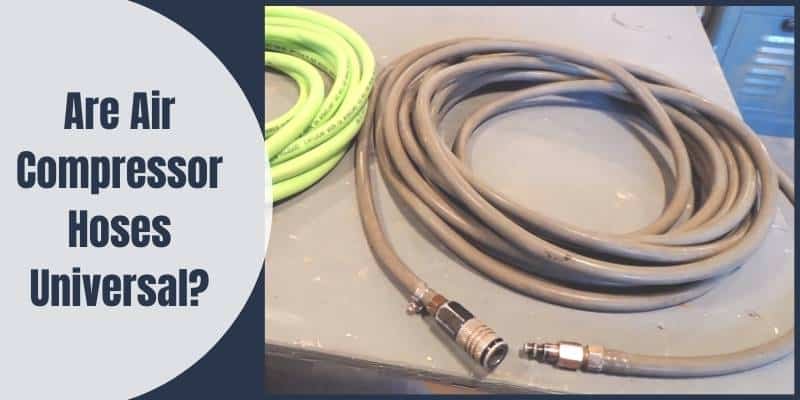Disclosure: This post contains affiliate links and I will be compensated if you make a purchase after clicking through my links. Learn More
Can I Connect 2 Air Compressors Together? Discover the power of combining air compressors to supercharge your pneumatic projects! In this guide, we’ll show you how to double your air supply, increase efficiency, and get the job done faster. Get ready to take your air-powered tasks to the next level!

Can I Connect 2 Air Compressors Together?
Before delving into the details, the short answer is “Yes, you can connect two air compressors together.” By doing so, you can effectively double your air supply, making it possible to tackle more demanding tasks that a single compressor might struggle with. However, it’s crucial to understand the process thoroughly to ensure safety and efficiency.
Understanding Air Compressors
Air compressors are mechanical devices that convert power into potential energy stored in pressurized air. They are used in a wide range of applications, from powering pneumatic tools to inflating tires and powering HVAC systems.
There are two main types of compressors:
- Reciprocating and
- Rotary screw.
Reciprocating compressors use pistons to compress air, while rotary screw compressors use screws. Both types have their advantages and disadvantages, and the choice between them will depend on the specific application.
One of the key metrics used to measure the performance of an air compressor is its CFM rating, which stands for cubic feet per minute. This measures the volume of air that the compressor can deliver at a given pressure.
The pressure rating of an air compressor is also important, as it determines the maximum pressure that the compressor can generate.
When considering whether to connect two air compressors together, it is important to ensure that their capacities and CFM ratings are compatible. Connecting two compressors with different capacities or CFM ratings can result in uneven air delivery and potentially damage the compressors.
Understanding the basic principles of air compressors and their performance metrics is essential when considering whether to connect two compressors together.
It is important to ensure that the compressors are compatible in terms of their capacities and CFM ratings in order to avoid potential damage and ensure optimal performance.
Connecting Two Air Compressors

Parallel Connection
Connecting two air compressors in parallel is a common practice to increase airflow and pressure in industrial settings. To connect two compressors in parallel, follow these steps:
- Make sure both compressors have the same voltage and phase.
- Install a check valve on each compressor’s discharge line to prevent backflow.
- Install a tee fitting on each compressor’s discharge line.
- Connect the two tee fittings with a pipe.
- Install a pressure switch on each compressor.
- Connect the pressure switches in parallel.
- Connect the air receiver tank to the tee fitting.
When connected in parallel, the compressors work together to supply more air to the system. This connection is suitable for applications that require high airflow but not high pressure.
Series Connection
Connecting two compressors in series is another way to increase pressure in a compressed air system. To connect two compressors in series, follow these steps:
- Make sure both compressors have the same voltage and phase.
- Install a check valve on each compressor’s discharge line to prevent backflow.
- Install a tee fitting on each compressor’s discharge line.
- Connect the two tee fittings with a pipe.
- Install a pressure switch on each compressor.
- Connect the pressure switches in series.
- Connect the air receiver tank to the tee fitting.
When connected in series, the compressors work together to supply more pressure to the system. This connection is suitable for applications that require high pressure but not high airflow.
It is important to note that connecting two compressors together requires careful consideration of the electrical and mechanical requirements.
Essential Components for Connection
When connecting two air compressors together, there are a few essential components that you will need to ensure that the system works properly. These components include:
Check valves: These are one-way valves that allow air to flow in one direction only. They are important for preventing backflow between the two compressors.
Pressure switches: These switches are used to control the operation of the compressors. They turn the compressors on and off based on the pressure in the system.
Tee: A tee is used to connect the two compressors together. It allows air to flow from one compressor to the other.
Outlet: The outlet is where the compressed air is released from the system. It should be connected to a regulator to control the pressure of the air.
Unloader valve: This valve is used to release the pressure in the system when the compressor is turned off. It prevents the compressor from starting under load.
Regulator: A regulator is used to control the pressure of the air in the system. It should be connected to the outlet.
Air line: The air line is used to connect the components of the system together. It should be made of high-quality material to prevent leaks.
Air manifold: The air manifold is used to distribute the compressed air to the tools or equipment that require it.
Pressure gauge: A pressure gauge is used to monitor the pressure in the system. It should be connected to the regulator.
By ensuring that all of these components are properly connected and functioning, you can create a reliable and efficient system for your compressed air needs.
Air Compressor Tanks
Air compressor tanks are an essential part of any air compressor system. They store compressed air, allowing you to use your air tools without having to run your compressor continuously.
Air tanks come in a variety of sizes, shapes, and materials, but they all serve the same purpose: to store compressed air.
The volume of an air tank is an important factor to consider when connecting two air compressors together. The total volume of the two tanks should be sufficient to power your air tools without having to run both compressors continuously.
Adding a larger tank to your system can increase the volume of compressed air available, reducing the need to run your compressors as often.
When connecting two air compressors together, it is important to ensure that the tanks are connected in parallel. This means that the air flows through both tanks at the same time, rather than one tank filling up before the other.
Connecting the tanks in series can cause one tank to fill up while the other remains empty, reducing the overall volume of compressed air available.
We know, air compressor tanks are an essential part of any air compressor system. When connecting two air compressors together, it is important to consider the volume of the tanks and connect them in parallel to ensure that you have sufficient compressed air available for your air tools.
Using Air Compressors with Tools
Air compressors are commonly used to power pneumatic tools, which are powered by compressed air. This can include tools such as nail guns, impact wrenches, and spray guns. Using an air compressor with tools can provide many benefits, including increased power and efficiency.
When using an air compressor with tools, it is important to make sure that the air tool is compatible with the compressor. This means checking that the air tool’s operating pressure and air flow requirements match the compressor’s output.
Using a tool with a higher air flow requirement than the compressor can provide can result in poor performance or even damage to the tool.
And checking compatibility, it is important to use the correct hose system when connecting the tool to the compressor. The hose system should be able to handle the air flow and pressure required by the tool, and should be of the appropriate length for the job.
Using a hose that is too long can result in a drop in air pressure, while a hose that is too short can restrict air flow.
When using air tools with an air compressor, it is also important to follow proper safety procedures. This includes wearing appropriate personal protective equipment, such as safety glasses and ear plugs, and making sure that the tool is properly maintained and lubricated.
It is also important to use the tool in a well-ventilated area to avoid inhaling any fumes or dust that may be generated during use.
Overall, using an air compressor with tools can provide many benefits, but it is important to make sure that the tool and hose system are compatible with the compressor, and to follow proper safety procedures when using the tool.
Potential Issues and Solutions
When connecting two air compressors together, there are some potential issues that you may encounter. Here are some of the most common issues and their solutions:
Load imbalance
If the two compressors have different capacities, there may be a load imbalance. This can cause one compressor to work harder than the other, which can lead to premature wear and tear. To solve this issue, you can use a load-sharing controller that will distribute the load evenly between the two compressors.
Synchronizing issues
When two compressors are connected together, they need to be synchronized to work together efficiently. If they are not synchronized, it can cause issues such as pressure drops and surges. To solve this issue, you can use a synchronizing controller that will ensure that the two compressors are working together in harmony.
Maintenance issues
When you connect two compressors together, it can be more difficult to maintain them. You will need to ensure that both compressors are maintained properly and that any issues are addressed promptly. Regular maintenance, such as oil changes and filter replacements, can help prevent issues from occurring.
Noise issues
When two compressors are connected together, they can be louder than a single compressor. This can be a problem if you are working in a quiet environment. To solve this issue, you can use soundproofing materials or install the compressors in a separate room.
Overall, connecting two air compressors together can be a great way to increase your air supply. However, it is important to be aware of the potential issues and to take steps to address them.
By using the right controllers and maintaining your compressors properly, you can ensure that your system runs smoothly and efficiently.
DIY Connection of Air Compressors
Connecting two air compressors can be a great way to increase your air supply. However, it’s important to be cautious and follow proper safety procedures when doing so. Here are a few steps to follow when connecting two air compressors together:
First, make sure that both air compressors are of the same type and model. This will ensure that they are compatible and will work together properly.
Next, turn off both air compressors and unplug them from their power source. This will prevent any electrical shocks or other accidents from occurring.
Locate the air intake filter on both compressors and remove them. This will allow air to flow freely between the two compressors.
Connect a hose to the air outlet of the first compressor and attach it to the air inlet of the second compressor.
Turn on both compressors and allow them to run for a few minutes to build up pressure. Once the pressure has stabilized, you can begin using your air tools.
It’s important to note that connecting two air compressors together can be dangerous if not done properly.
Overall, connecting two air compressors can be a great DIY project for those who need more air supply. Just be sure to follow proper safety procedures and take your time to ensure that everything is done correctly.
Economic and Spatial Considerations
When considering connecting two air compressors, economic and spatial considerations are important factors to keep in mind. Here are some things to consider:
Save Money
Connecting two air compressors can be a cost-effective solution for those who need more air power but don’t want to invest in a larger, more expensive compressor. By connecting two smaller compressors, you can achieve the same air output as a larger compressor at a lower cost.
Oil-Free
If you require oil-free air, connecting two oil-free compressors is a good option. This allows you to maintain the oil-free quality of your air supply while increasing the air output.
Space
Connecting two compressors can also be a space-saving solution, especially if you have limited space in your workspace. Instead of investing in a larger compressor, you can connect two smaller ones and save valuable floor space.
Power Source
Before connecting two compressors, it’s important to ensure that your power source can handle the increased load. Make sure to check the power requirements of both compressors and ensure that your power source can handle the combined load.
Overall, connecting two air compressors can be a practical solution for those who need more air power without breaking the bank or sacrificing valuable workspace. By considering economic and spatial factors, you can ensure that connecting two compressors is the right choice for your needs.
Specific Use Cases
Air compressors are essential tools in many industries, and connecting two compressors together can have several benefits. Here are some specific use cases where connecting two air compressors can be useful:
Painting: If you are a professional painter or run a painting business, you need a constant supply of compressed air. Connecting two compressors together can give you a higher volume of compressed air, which can help you complete your painting jobs faster and more efficiently.
Plumbed systems: If you have a plumbed air system in your workshop or garage, connecting two compressors together can help you maintain a constant supply of compressed air. This is especially useful if you have a large workshop or garage and need to power multiple air tools simultaneously.
Larger compressor: If you have a larger compressor that does not provide enough compressed air for your needs, connecting a smaller compressor to it can help increase the volume of compressed air. This can be useful if you have a specific job that requires more compressed air than your larger compressor can provide.
Cut in and cut out: Connecting two compressors together can help you achieve a higher cut in and cut out pressure. This means that your compressors will turn on and off less frequently, which can save you energy and reduce wear and tear on your compressors.
In conclusion, connecting two air compressors together can be useful in several specific use cases. However, it is important to ensure that the compressors are compatible and that you follow the manufacturer’s instructions for connecting them.
Frequently Asked Questions
How can I connect two air compressors together?
You can connect two air compressors together by using a Y-connector or a manifold. The Y-connector will allow you to connect two hoses to a single outlet, while a manifold will allow you to connect multiple hoses to multiple outlets.
What is the benefit of connecting two air compressors together?
Connecting two air compressors together will increase the amount of air flow, or CFM, which can be useful for larger projects that require more power. It can also provide a backup system in case one compressor fails.
What is the maximum number of air compressors that can be connected together?
There is no set maximum number of air compressors that can be connected together, but it is important to ensure that the combined CFM of the compressors does not exceed the capacity of the tools being used.
What is the recommended way to connect two air compressors for more CFM?
Connecting air compressors in parallel is the recommended way to increase CFM. This involves connecting the compressors to the same manifold or Y-connector so that they both feed into the same air hose.
What is the difference between connecting air compressors in series and in parallel?
Connecting air compressors in series involves connecting the output of one compressor to the input of another, which can increase the pressure but not the CFM. Connecting air compressors in parallel allows for an increase in CFM.
What type of air check valve should I use when connecting two air compressors?
It is recommended to use a high-quality brass check valve when connecting two air compressors. This will prevent backflow and ensure that the compressors remain pressurized.


